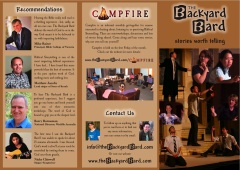Here is a sample rundown of a workshop for Biblical Storytelling.
After giving an introduction about The Backyard Bard as a group, doing an example storytelling and discussing the value of stories in the Bible - the workshop is divided into two halves: "Connecting" and Communicating". These two ideas summarise they way we think about the Biblical Storytelling.
Connecting with the story
Our fundamental idea is that you first need to connect with a passage in the Bible yourself before you can communicate it in a meaningful way to others. You could try to memorise a passage of the Bible and recite it to an audience - but if it hasn't moved you and made a deep connection in your heart, then you're more likely to put people to sleep than give them an experience of God's living Word.
We do three activities in this section. Everyone is given a story from Mark's Gospel and then do three activities to explore the story from three angles. They are to see that it is a story about a Real Event, about Real People and about a Real God.
Real Event
Everyone has a partner read to them their story from Mark as they imagine that they were there to see it with their own eyes. I encourage them to close their eyes and visualise the events and to experience the story as an eyewitness would of. We feel distant to the Bible stories because they happened so long ago and in a far away place. We need to bridge that gap ourselves before we ask our audience to. If you had actually seen Jesus calming the storm yourself, you'd never be able to retell the story in the monotone that we sometimes use in church Bible readings! Often when people do this exercise - they will pick up aspects of the stories they'd never noticed before.
Real People
The next activity is to discuss the characters in the stories with your partner. This involves talking about who they are, why they do what they do and why they say what they say. What emotions are they feeling? How does what happen in the story affect them? Try to see the story from each of their perspectives. These stories are filled with amazing characters with complex motivations whose lives were changed by these events. It's extremely important to relate to the story from their level.
Real God
One of the great things about the stories in the Bible is that they demonstrate for us God in action. At this stage in the workshop, I ask people to shut their eyes as I ask them three questions and give them time to reflect on them:
- What would be missing from our understanding of God and Jesus if this story were not written down?
- How could my life be different if I honestly whole-heartedly understood and believed this truth about God?
- Can I imagine someone whose life could be changed by the truth about God in this story?
When we do storytelling from the Bible, we are introducing people to the living God. We need to communicate it in a way that reflects this truth.
Communicating the story
Once we've connected with the story ourselves, we'll naturally want to communicate it as best we can. Stories are told in different ways in different contexts and cultures. It's still Biblical Storytelling even if you aren't doing it in the Backyard Bard's style of storytelling. In general, a storyteller has three tools in the toolbox: voice, body, space - in that order of importance.
Voice
Your voice is the most important tool. It may be the only tool you can use (for example: if you are storytelling over the radio). With your voice, you are an emotional guide to your hearers. You can communicate so much of the various aspects of the story and the characters merely in the way you say it. The most important element here is experimentation. Say the passage in as many different ways - each time will communicate truths about the passage in different ways. In the workshop, I only have time for people to read the story once to a new partner. The exercise is to read it as if you were there and you saw it with your own eyes (similar to the first exercise in the previous section).
Body
Your body is a powerful tool to engage people with the visuals of the story. With your body, you can gesture, mime, act out and even portray different characters. In the workshop, I get people to tell the story from a chair, using gestures to indicate all the action in the story. I encourage people to think of the conductor of an orchestra or even the Sorcerer's Apprentice from Fantasia, as you create an imaginary world with your hands - characters coming and going, as well as vast crowds and small mustard seeds.
Space
Using space, a storytelling can create an imaginary world on stage. The trick always is to visualise it yourself first. The general rule is - when you see it, others see it too. To explore that idea there's an exercise where you get to be an Bible Imagination Tourist. In the each story, there will be landmarks, locations, textures, smells. People go through their stories line-by-line and exploring all the visuals of the story around them. Does your story speak about the Temple? Imagine walking through the gates of the temple - what does it look like? how high is it? what is the colour of the stones? etc. The more precise and intricate the imaginary world you explore the better.
That's all the time that we have for the workshop. At this stage there's usually only a few minutes for people to practice telling their stories and hopefully there's time for a volunteer to tell one to the group. It's a only a very brief introduction to Biblical Storytelling but I hope that it's enough to whet people's appetite. After all, Biblical Storytelling is really quite easy - anyone can give it a go. Why not go through the workshop above and give it a go yourself (even better - book us in for one of these workshops at your church;) )



































